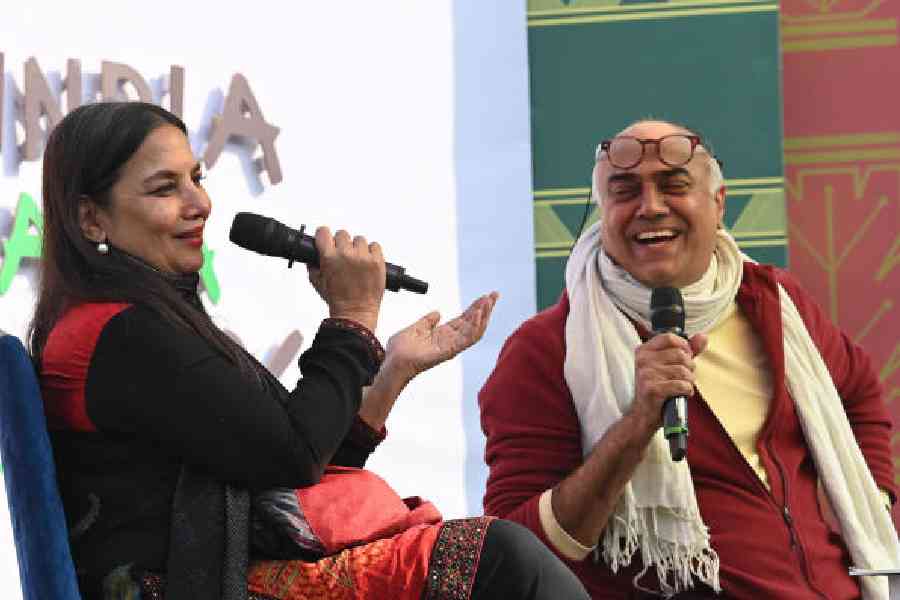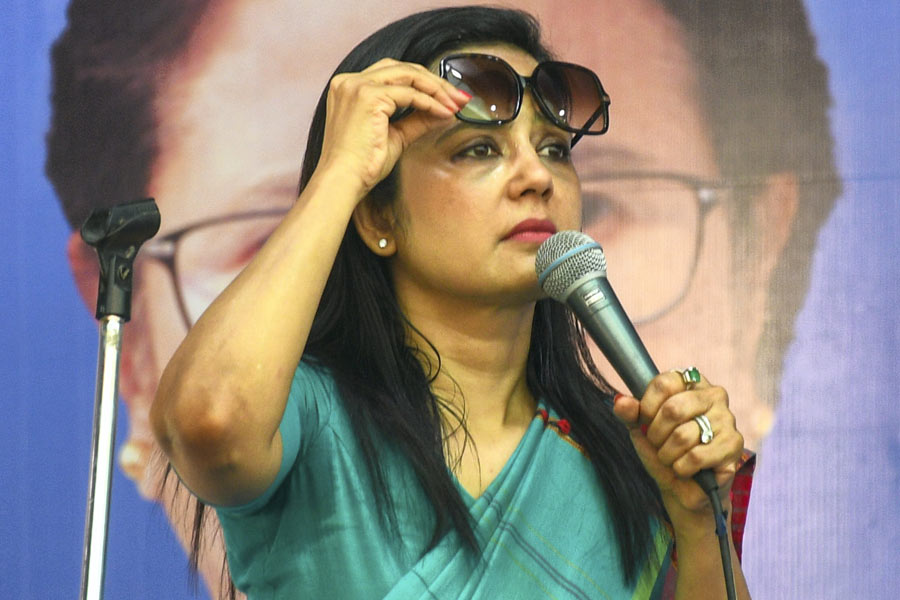Reiterating the genius of legendary filmmaker Shyam Benegal and making the audience aware of some unknown facets of him at Coal India Kolkata Literary Meet 2025 were actors Shabana Azmi and Rajit Kapur in the session ‘Seeding A New Cinema: The Legacy of Shyam Benegal’. Moderating the session adroitly was Priyanka Roy of t2 who made the two actors open up about their experiences of making their debut in the industry with Benegal and share anecdotes that only added to his legacy and enriched us.
Rajit’s ‘Suraj ka satvan ghoda’
On an emotional note, the session kicked off with Rajit invoking Shakespeare’s words and informing how words like ‘father figure’, ‘guide’ and ‘philosopher’ fall short when describing his relation with Benegal. “I feel good when I talk about him,” he said with an emotion of sadness mixed with fondness. He added: “Metaphorically, I can call him my ‘suraj ka satvan ghoda’. Somewhere he was the seventh horse and the smallest horse brings a sense of balance.”
Shabana’s ‘reluctant guru’
Taking up from Kapur, Azmi, who has done films like Mandi and Ankur among others, with Benegal called the filmmaker her friend and ‘reluctant guru’. “Shyam to me was a guru, a mentor, a guiding light… I would often turn to him when I was confused about a role in a film. Above all, he was a friend. He was the one who gave me the privilege of that space. I would insist he was my reluctant guru.” Sharing her experience of travelling to Berlin with Benegal and talking about how he shaped her life she adds: “It was not just the experience of working with him in my first film but travelling with him that taught me a lot. Being around him was such a learning experience in every way. He was such an interesting person. I really owe a lot to him. He really shaped my aesthetics.” Agreeing with Azmi, Rajit was reminded how Benegal was called the ‘Walking Encyclopaedia’.
Sensitivity towards actors
In the flow of the conversation, Azmi shared the actor-director/mentor relationship she shared with Benegal. “If he liked my work he called once or twice and if he didn’t like my film, he would call thrice. Only somebody who loves you deeply will take the trouble. And I valued it. I also argued my way out at time, but just the fact that he would do this to me was so precious. It was the best relationship between an actor and director. He didn’t tell the actor what exactly he wanted, rather he would say how he feels and give the actors the scope to take risk. You could take many more risks that you otherwise couldn’t take. With Shyam, you could take risks because you know if you are making a fool of yourself he would stop you.”
Benegal was a man of few words and Rajit informed how he never used superlatives to praise his actors or criticise them. Also, the fact that he would fill the actors with a sense of responsibility towards the scene and the film.
The Uncanny Benegal
Making the audience aware of the uncanny side of Benegal or the method to his madness, Azmi shared how during the filming of Mandi, Benegal instructed his assistant directors to treat all 40 actors equally. “When we were doing Mandi, there were 40 actors who were either from NSD (National School of Drama) or FTII (Film & Television Institute of India). Some had big parts while others had small parts. He created such an atmosphere of fun that there was no hierarchy. I thought this was natural. But I got to know that day before his shoot, he called his ADs and said that you are dealing with 40 egos, all of them are actors who are good and talented, so make sure you look after the people who have smaller parts first so that egos are not bruised. There was a method to the madness. There was a design to what he was doing.” Pitching in, Rajit talked how reality hit when one stepped out of Shyam Benegal’s sets and discovered different categories or the hierarchies that didn’t exist while working with Benegal.
The ultimate collaborator
“He was a collaborator in the finest meaning of the term because he valued all the people. He knew film is a collaborative medium despite the fact that the director is the captain of the ship, it’s also the director’s business to take on people he valued for their work and allowed them to be creative enough without losing their spontaneity,” said Azmi confessing the reason she never donned the director’s challenging hat. Small things made a difference to his sets including the facility of toilets for all. Weighing in, Rajit added how observant Benegal was. “If you are not there he would notice for breakfast. He would notice small things. And it could be anyone, from the technicians to the actors.” Both of them recalled their time with Benegal during Ankur and Suraj Ka Satvan Ghoda.
Giving voice to the voiceless
The avant-garde filmmaker is known to have picked up themes of social change and throwing light on that, Azmi reflected: “The films that he made were or are in some sense classic, so they go past any strains of time and they can translate into other situations. The things that he did were not self conscious. He was not wearing the flag of socialism. He was just looking at things with curious eyes.” Azmi also shared about the time she was worried about him. “I felt that now he is becoming so strongly identified as a director with a cause that he is choosing his subjects according to that. It’s like a mould was created… But what was wonderful was when he was in Parliament and how he translated it into a film, Well Done Abba. It was magical.”
Rajit pointed at the personalised stories that marked Benegal’s filmography. “Right from Ankur in 1971 to his last film Mujib, I don’t think there’s any other director in the country whose filmography gives you a social, an economic and, yes to an extent, political overview of our existence spectrum and fabric of our country; the complete arch of what we are is embed in these personalised stories.”
‘Walking advertisement’ at Cannes
Sharing an interesting anecdote from her first Cannes experience, Azmi talked about how Benegal devised a mechanism to manage a crisis and the result was worth the effort. “While we were in Cannes to promote our film, we realised that the advertising material hadn’t arrived. It meant that our film wouldn’t get publicity. Shyam asked Smita (Patel) and me to wear our Kanjivarams and waltz at the promenade. We did that and people looked at us with curious eyes, we went up to them and told them we had a screening. And our screening was houseful! That’s the advertising man for you. This was “walking advertising”.
Women in his films
“He broke stereotypes and presented female characters with an agency and with all the complexity and frailty. I remember when I did Ankur, a lot of people objected to the fact that the character, played by me, stole rice. They thought it was a negative thing to do. But that’s what made her real. He presented her in her complexity,” said Azmi, proceeding to talk about her experience of visiting three brothels before the shooting of Mandi. “Visiting brothels changed a lot of my perception about them. In a Delhi brothel, we met a diminutive girl who was asked to dance on a devotional song based on one of my films. She broke into the most vulgar depiction of Puja karungi and then suddenly went back to being herself. That was all a performance,” enthused Azmi informing how Naseeruddin Shah got the part of Tungrus from that session.
Manthan to Bharat Ek Khoj
Manthan, India’s first crowd-funded film, that made global headlines last year, also made it to the discussion and talking about Benegal’s finesse in tackling complex situations, Azmi said: “He did tackle difficult situations and did that very naturally. When he heard about the co-operative movement of the farmers, he naturally said that if they are already in a cooperative situation, how about we ask them to contribute to the film. I don’t think he said that to shake the world; he did that very naturally.” He was a man who wouldn’t shy away from experimenting, and Rajit added: “I think the man himself was ready to experiment, not just through his films but as a person.”
This discussion led to the revelation on Benegal’s temper by Azmi. “When he flew into a temper, which he rarely did, he used to become very abusive. And the expletive he would use was D-O-N-K-E-Y!”
Another masterpiece that Benegal worked on, Bharat Ek Khoj, a cultural encyclopaedia, added a new dimension to the session that had the audience in rapt attention. “He was a great admirer of Nehru. Pluralism and secularism was in his blood. When he decided to make Bharat Ek Khoj, he said: ‘It’s also my discovery.’ Thank God for it because all the history that is being wiped out…” Quicky adding, Rajit rightly mentioned that it should be studied at schools in India.
Benegal Forever
There will never be another Shyam Benegal but his legacy and light will continue to guide us and illuminate us. Referring to the maverick as a ‘torch’ Rajit concluded the session with: “His light is in all of us. Everyone has imbibed something. There are so many filmmakers who are studying him in film institutes. He is like a torch. It is you who have to figure it out where to light it and whether to ignite it or not.”











